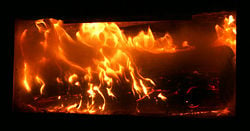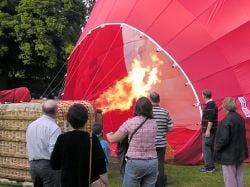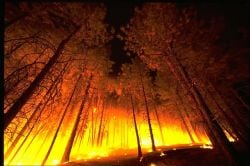Fire
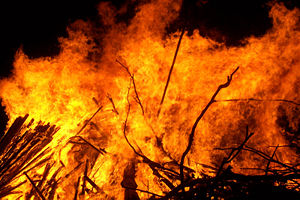
Fire occupies a unique place in nature. It is not matter itself, but it involves the reaction of different types of matter to generate energy in the form of heat and light. It can be an agent of destruction, especially when uncontrolled, but it also serves many beneficial functions. In early geological history, it appears that fires started by lightning strikes and volcanic eruptions shaped the Earth and helped prepare the environment for habitation by a huge diversity of life forms. Even today, periodic forest fires and brush fires are part of nature's cycle of destruction and renewal.
Human beings, among all the species on Earth, have the unique ability to control fire. Based on this ability, fire has played an enormous role in the development of human civilization. Human scientific and technological advances, as well as their everyday lives, depend on the controlled use of fire. Fire is used to cook food, heat homes, run engines, smelt metals, generate electricity, and drive all manner of industrial processes.
Ancient philosophers considered fire as one of the fundamental "elements" of nature, while religious thinkers regarded the heat and light of fire as metaphors for God's love and truth, respectively. A flickering flame is a thing of beauty and endless fascination.
What is fire?
When we see a piece of wood burning, with flames leaping and smoke rising, we say that the wood is "on fire." But what is fire? In general terms, fire is a high-temperature chemical reaction in which a fuel rapidly reacts with an oxidizing agent to generate heat, light, and a variety of products. In other words, fire is not matter itself, but it is the interaction of some forms of matter (such as hydrocarbons and oxygen) at a relatively high temperature to generate other forms of matter (such as carbon dioxide and water) and energy (heat and light).
The fuel may be a solid (such as wood or paper), a liquid (such as oil or gasoline), or a gas (such as hydrogen or natural gas). The oxidizing agent is usually oxygen. Gasoline and natural gas are mainly composed of hydrocarbon molecules, while wood and paper contain long-chain carbohydrates (such as cellulose). When these fuels are burned in oxygen, the main products are carbon dioxide, water vapor, and carbon particles. If the fuel contains nitrogen and sulfur, oxides of these elements are produced as well.
Some fires occur in the absence of oxygen. For instance, hydrogen can burn in chlorine to produce hydrogen chloride (HCl). Other possible combinations that produce flames include hydrogen and fluorine or hydrazine and nitrogen tetroxide.
It takes a spark to start a fire. In scientific terms, the fuel—when surrounded by the oxidizing agent—needs to be heated until it reaches a temperature known as its ignition point. While it may seem like a handicap to someone trying to start a fire without a source for a spark, this requirement has a protective effect, considering how dangerous it would be if most fuels could burst into flames simply by being exposed to air at ordinary temperatures. (Some extremely flammable fuels have a low ignition temperature and are therefore stored in air-tight containers away from oxygen.)
At the ignition temperature, some of the fuel is converted to flammable gases, which then react with the surrounding oxygen gas. Once started, the fire usually generates sufficient heat to sustain itself until the available fuel or oxygen is used up. But if the heat generated by combustion does not keep the temperature at or above the ignition point, the fire will die out.
Some chemicals called accelerants can be used to spread fire faster or have it burn hotter. Common accelerants are hydrocarbon-based fuels, including gasoline, diesel fuel, kerosene, turpentine, and butane.
To put out a fire, one has to do at least one of two things: (1) Cool the reacting matter until the temperature falls below the ignition point, or (2) prevent the oxygen (or other oxidizing agent) from contacting the fuel. Cooling the reaction is usually accomplished by pouring cold water on the burning matter. Alternatively, one can use a fire extinguisher to spray nonflammable material onto the fuel, thereby smothering the fuel and cutting off the oxygen supply. A third alternative—removing the fuel from the site of combustion—is usually not practical, as the fuel may be too hot or difficult to move.
The flame
The flame consists of gases, solid particles, heat, and light. The bright red-orange color of a flame is attributable to the presence of solid particles (mainly carbon) that have been heated to incandescence. These solid particles form the soot emitted by the fire. The flame also derives part of its light from gas molecules, when some of their electrons undergo transitions from higher to lower energy levels.
The color of the flame depends on its chemical composition, the temperature of combustion, and the extent of combustion of the fuel. Take the example of a Bunsen burner that burns methane gas, using oxygen from the air. If we restrict the amount of oxygen that mixes with the gas, the combustion is incomplete and produces a yellow flame at roughly 1,000°C. As additional oxygen is allowed to mix in, the extent of combustion increases, and the flame turns increasingly blue. The blue part of the flame is around 1,600°C. By comparison, the flame temperature of a blowlamp can be 1,300°C and that of a candle can reach 1,400°C. An oxyacetylene combustion can be as hot as 3,000°C.
Generally speaking, a red flame is relatively cool. As the flame's temperature increases, its color turns to orange, yellow, white, violet, blue, and bright blue. For a given region of a flame, the closer it gets to white, blue, or bright blue, the hotter that region is.
In addition, when salts of different metals are heated in the flame of a Bunsen burner, they produce specific colors in the flame. For instance, sodium salts produce a yellow flame, potassium salts give a violet color, and copper salts make the flame green or blue green.
Usefulness of controlled fire
Learning to control fire was one of the first great achievements of hominids. Some paleontologists indicate that Homo erectus may have used controlled fire as early as 790,000 years ago. Other evidence from the site named the "Cradle of Humankind" in South Africa suggests the controlled use of fire more than a million years ago. But reliable means of starting a fire—such as by the use of wooden drills or flintstones—has been traced to the Neolithic age, around 7000 B.C.E.
For early peoples, wood fires were a main source of energy. The ability to control fire enabled them to cook food—a decisive step in the fight against disease—and to migrate to colder regions of the world. Controlled flames also offered a means of lighting dark places. Another use of fire was in long-distance communication through smoke signals.
By the time of the Neolithic introduction of grain-based agriculture, people the world over used fire as a means to clear fields, produce fertilizer (by burning trees and grasses), and manage landscapes. For instance, controlled fires helped clear the undergrowth in forested areas, thereby facilitating hunting and improving the yield of root and berry crops. Fire was also used to clear travel lanes.
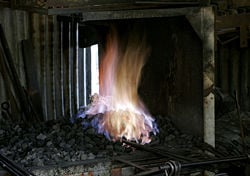
Later, fire enabled advances in metallurgy, such as smelting and forging, and alchemists used fire to discover and perform a variety of chemical reactions. That type of work contributed to the foundations of our modern technological society. Today, the energy needs for modern homes, offices, industries, agriculture, and means of transportation rely, for the most part, on the burning of fuel, either directly or indirectly.
When people use electricity, fuel is not burned on site, but most of the world's electricity is generated by power stations that burn coal, oil, or natural gas. At a power station, fire is used to heat water, creating steam that drives turbines. The turbines are linked to an electrical generator. In most developing countries and remote areas, however, wood continues to be the primary energy source.
There is also a long history of the use of fire in warfare. Homer detailed its use by Greek commandos who hid in a wooden horse to enter Troy and burn the city during the Trojan War. A more recent example is the use of napalm, consisting of gasoline jelled in aluminum soaps, to kill and maim people and destroy infrastructure.
Uncontrolled fire
Uncontrolled fires are extremely dangerous, as they spread swiftly, destroy property, and kill and injure living things.
Naturally occurring wildfires consume huge areas of forests and grasslands. In the long run, however, these fires also have certain beneficial effects. They thin out forests, free up nutrients from wood, and encourage vegetation that depends on regular burns for survival. Knowing the role of fire in ecosystems, forest rangers may use "prescribed burns" to reduce the hazards of undergrowth and dead fuels.
In day-to-day human lives, structure fires can be started by cooking accidents, electrical faults, fuel leaks, children playing with lighters or matches, and accidents involving candles and cigarettes. Fire can propagate rapidly to neighboring structures, especially when proper building standards are not met. Purposefully starting destructive fires constitutes arson and is a criminal offense in most jurisdictions.
Given the destructive capacity of fire, most municipalities offer firefighting services to quickly extinguish fires. Trained firefighters use fire trucks, fire hydrants, and an array of other equipment to combat the spread of fires.
Uncontrolled fires have been classified according to different systems. In the United States, they are classified into four groups, as follows.
- Class A: Fires that involve flammable solids such as wood, cloth, rubber, paper, and some types of plastics.
- Class B: Fires that involve greases, flammable liquids (including gasoline, oil, and paint), and flammable gases (such as natural gas and propane).
- Class C: Fires that involve any of the materials found in Classes A and B, but with the presence of any electrical appliances, wiring, or other electrically energized objects in the vicinity of the fires.
- Class D: Fires that involve combustible metals, such as sodium, magnesium, and potassium.
Occasionally, a fifth group, Class K, is added. It refers to fires involving large amounts of grease or oil. Although Class K is a subclass of Class B, the special characteristics of these types of fires are considered important enough to recognize.
In Europe and Australasia, six groups are used:
- Class A: Fires that involve flammable solids such as wood, cloth, rubber, paper, and some types of plastics.
- Class B: Fires that involve flammable liquids or liquefiable solids such as gasoline/petrol, oil, paint, some waxes and plastics, but not cooking fats or oils.
- Class C: Fires that involve flammable gases, such as natural gas, hydrogen, propane, and butane.
- Class D: Fires that involve combustible metals, such as sodium, magnesium, and potassium.
- Shock Risk (formerly known as Class E): Fires that involve any of the materials found in Classes A and B, but with the presence of any electrical appliances, wiring, or other electrically energized objects in the vicinity of the fires, with a resultant electrical shock risk if a conductive agent is used to control the fire.
- Class F: Fires involving cooking fats and oils. The high temperature of the oils when on fire far exceeds that of other flammable liquids making normal extinguishing agents ineffective.
Fire in philosophy and religion
In Greek mythology, Prometheus was the Titan honored chiefly for stealing fire from the gods in the stalk of a fennel plant and giving it to mortals for their use. On a more mundane level, Greek philosopher Empedocles proposed, in the fifth century B.C.E., that fire was one of four unchanging elements that were the basic constituents of all material things. The other three elements he proposed were air, water, and earth. For the ancient Chinese, there were five basic elements: Fire, water, earth, metal, and wood. The modern concept of elements was not formulated until the seventeenth century, when Robert Boyle defined them as material substances that could not be broken down into simpler substances.
Fire also plays an important role in the symbolism and rituals of many religions. For instance, candles and oil lamps are often used in places of meditation and prayer. Just as light dispels darkness, the light of a flame has been taken as a metaphor for goodness that dispels the darkness of evil. In addition, the heat and light of fire may be seen as metaphors for God's love and truth, and the upward movement of the flame may be seen as pointing toward a higher realm.
In Hinduism, fire is regarded as one of five sacred elements that make up all living creatures and as an eternal witness essential to sacred ceremonies. The Zoroastrian religion considers fire as a symbol of the invisible God, or Ahura Mazda, and each temple—called a fire temple—maintains a holy flame. In Judaism, believers light candles to usher in holidays, separate Shabbat from the rest of the week, and remember the dead. The Jews also had the tradition of maintaining an Eternal Flame in the First and Second Temple.
Christians regard fire as a symbol of the Holy Spirit, but they also point to biblical verses that prophesy a time when the world will be judged by fire (2 Peter 3:12; Malachi 4:1). Jesus is recorded as saying that he came to "cast fire upon the earth" (Luke 12:49). Many Christians regard these words about judgment by fire as symbolic, and not to be taken literally. The prophet Jeremiah likened fire to God's word (Jeremiah 23:29), hence "judgment by fire" can be a metaphor for judgment by God's truth.
ReferencesISBN links support NWE through referral fees
- Pyne, Stephen J. World Fire: The Culture of Fire on Earth. University of Washington Press, 1997. ISBN 978-0295975931
- Pyne, Stephen J. Fire: A Brief History. University of Washington Press, 2001. ISBN 978-0295981444
- Pyne, Stephen J. Between Two Fires: A Fire History of Contemporary America. University of Arizona Press, 2015. ISBN 978-0816532148
- Ward, Michael J. Fire Officer: Principles and Practice. Jones & Bartlett Learning, 2014. ISBN 978-1284068368
External links
All links retrieved March 26, 2024.
- Helmut Kaiser Consultancy Study: Fire Protection Industry Worldwide Innovation and Emerging Markets 2004–2010–2015
- "Early human fire skills revealed," BBC News
Credits
New World Encyclopedia writers and editors rewrote and completed the Wikipedia article in accordance with New World Encyclopedia standards. This article abides by terms of the Creative Commons CC-by-sa 3.0 License (CC-by-sa), which may be used and disseminated with proper attribution. Credit is due under the terms of this license that can reference both the New World Encyclopedia contributors and the selfless volunteer contributors of the Wikimedia Foundation. To cite this article click here for a list of acceptable citing formats.The history of earlier contributions by wikipedians is accessible to researchers here:
The history of this article since it was imported to New World Encyclopedia:
Note: Some restrictions may apply to use of individual images which are separately licensed.
